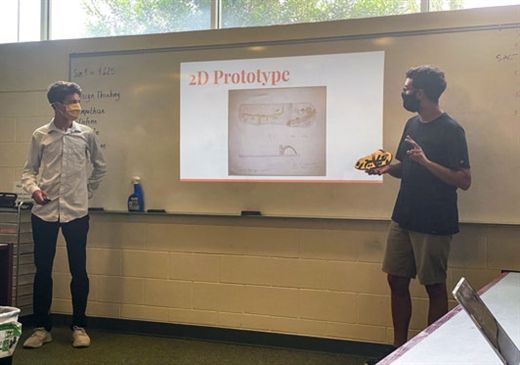

Inaugural Applied STEAM and Entrepreneurship Course
Upper School students at Shorecrest have a number of opportunities to pursue areas of interest in depth throughout the 9th-12th grade curriculum. Signature programs like the Global Scholars Initiative (launched in 2011) and the Center for Medical Sciences (launched in 2016) offer formal, sequenced tracks of study and extracurricular opportunities for students passionate about global studies and applied medical sciences, respectively. New this school year, students may choose to pursue the STEAM signature program, a specialized track that allows them to earn a certificate in one of the three STEAM areas of study - Computer Science, Engineering, or Entrepreneurship and Design.
In addition to taking at least three courses within their specific area of study, students must participate in the Seminar in Applied STEAM and Entrepreneurship in which they work on a self-directed culminating project.
The inaugural Seminar in Applied STEAM and Entrepreneurship is currently in progress under the direction of Dr. Anna Baralt, Director of Educational Technology, with four senior students enrolled.
“Like so many things this year, this class had to pivot due to COVID-19 and the necessary health and safety protocols,” says Dr. Baralt. “Originally, the course was designed to have students out in the community and to create something for their younger peers as the culminating project, which we wanted to adapt to limit mixing groups and visitors. The students have been so responsive and open with the changes, I think they’ve only made the course better - part of being an entrepreneur is adapting to unforeseen circumstances!”
After weeks of work, the seniors - Zachary Carmack '21, Spencer Mendelsohn '21, Rylan Richardson '21 and Anthony Vivio '21 - presented phase one of their projects to a small, socially-distanced group of administrators. In groups of two, the students were charged with using the design thinking process to create a product, specifically a shoe, whose brand sends a social message and is connected to one of the United Nations Sustainable Development Goals.
“I was impressed with prototypes of the shoes which demonstrated the hands-on nature of the project. There was a lot of thought put into the design-thinking and purpose of the product,” said Head of School Nancy Spencer who attended teams’ presentations.
Each group explained the five-step design thinking process to their audience: Empathize > Design > Ideate > Prototype > Test - then discussed their choice of Sustainable Development Goal to pursue.
Group 1, Vivio and Mendelsohn, chose to support the environment, aiming to promote the planting of trees and use of recycled materials in their product. Their shoe - a unisex sandal made of hemp canvas, hemp plastic and cork - is designed with seeds embedded into the sole, allowing the shoe itself to be planted once it’s outlived its usefulness as footwear. From testing the product with their target audience, they learned that they couldn’t necessarily charge more for an eco-friendly product and that their target customer prioritized the aesthetic appeal of the shoe over its responsibly sourced materials and manufacturing process. As they progress with their project, they’re challenged to think about how to merge the fashion and function of the product to meet their sustainability goal and customer preferences.
Group 2, Richardson and Carmack, designed “The Shoe for a Better Future,” a footwear product intended to partner with Malala Fund and be a symbol of the importance of women’s education in Pakistan. Designed for a female customer base, the shoe was made of responsibly sourced leather and included design elements that reflected connections to education, feminism, and Arabic culture throughout. A premium product with a price point of $135, the shoes supported women’s education with half of the cost of each pair going back to Malala Fund.
Through audience feedback, the students were challenged to think about their target audience, differences in cultural interpretations, brand positioning, and how to improve upon their ideas for the next phase of the project.
“I was really impressed with the idea of designing for and with a purpose, and how the process begins with empathy for the population being served,” said Diego Duran-Medina, Director of Service Learning and one of the audience members in the presentations. “It was great to see our Core Value of compassion applied in a classroom context through STEAM.”
Roderick Avery Fludd, Director of Diversity and Inclusion, was also in the audience. He shared, “The presentations were very impressive. Not only were they well researched and designed, but the causes they supported were also vetted and noteworthy. I wondered about the target audience and liked their responses to how they focused on gender specific audiences.”
The students will maintain a portfolio of their work throughout the year-long course. The Class of 2021 will be the first group to whom the STEAM certificate is offered.
#ShorecrestSTEAMCert





















